Management Accounting: Methods, Benefits, and Integration Analysis
VerifiedAdded on 2023/01/12
|17
|4333
|22
Report
AI Summary
This report provides a comprehensive overview of management accounting, detailing its role in managerial decision-making and its distinction from financial accounting. Section 1 explains management accounting, its essential systems, and reporting methods, including inventory management, job costing, price optimization, and cost accounting systems. It evaluates the benefits of these systems and their integration. Section 2 compares absorption and marginal costing, presenting cost cards and interpretations. Section 3 and 4 delve into further aspects of management accounting, including the evaluation of the benefits of MA systems and their application. The report emphasizes how management accounting contributes to organizational goal achievement and enhances efficiency. The report also highlights the role of different MA systems in the smooth functioning of an organization.
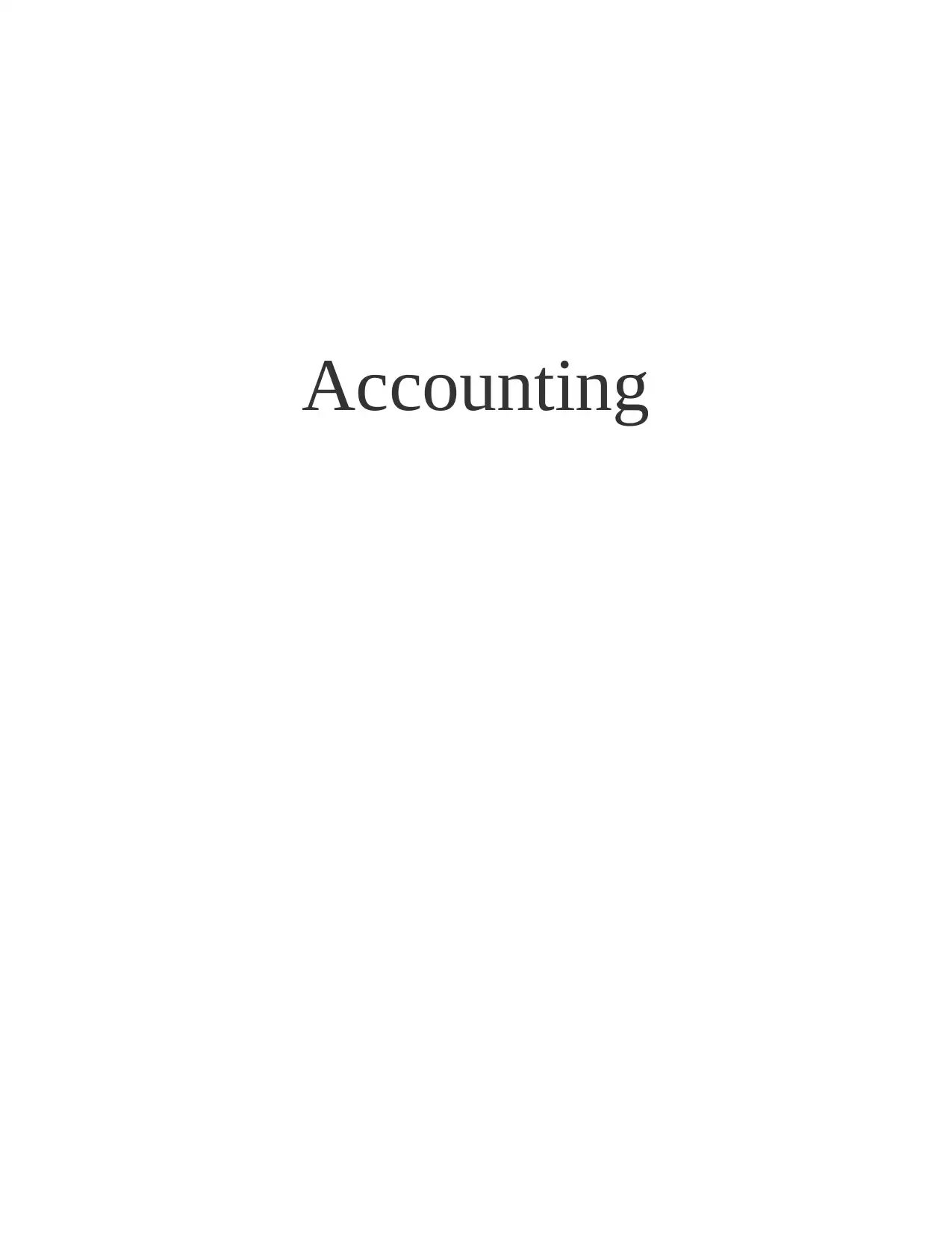
Accounting
Paraphrase This Document
Need a fresh take? Get an instant paraphrase of this document with our AI Paraphraser
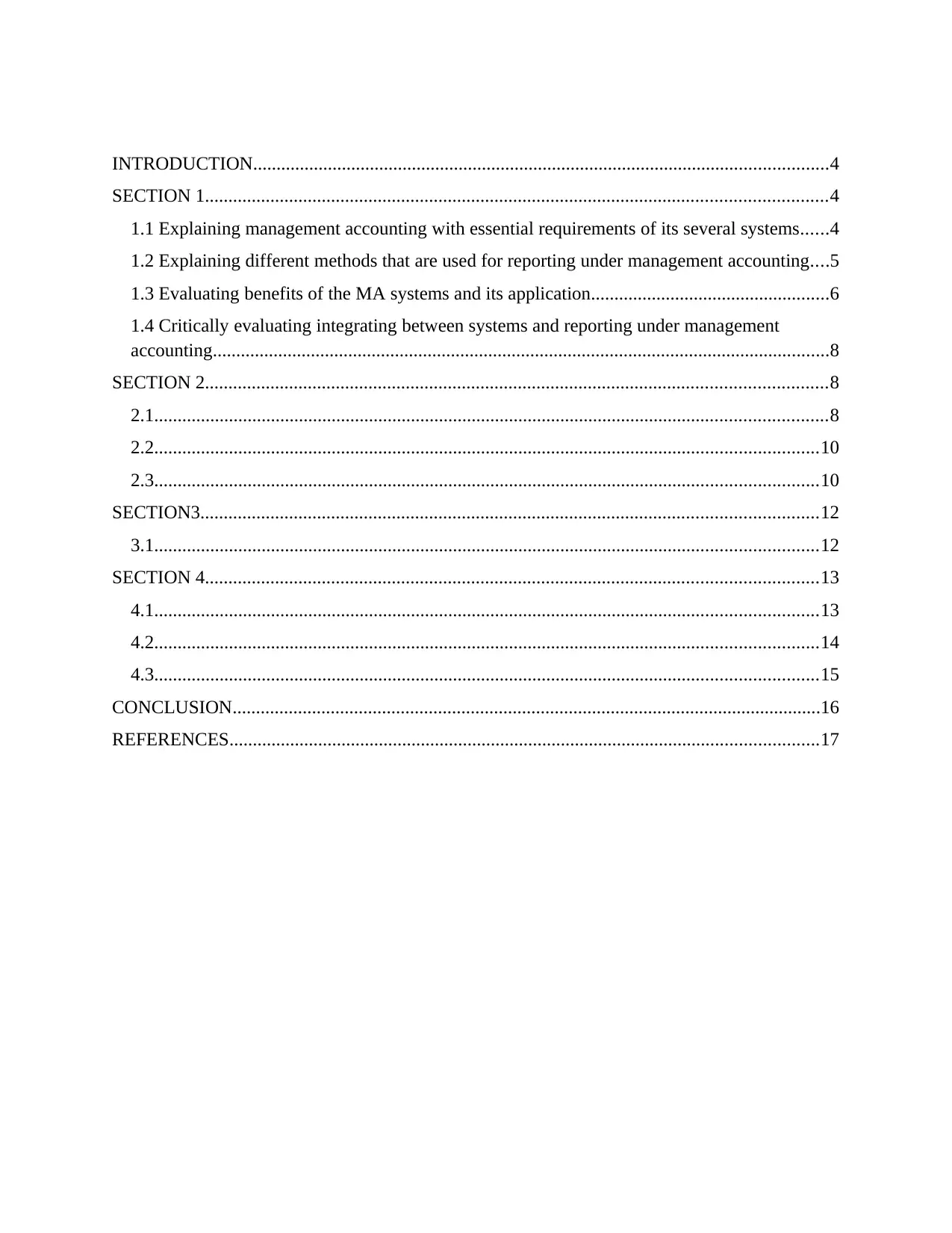
INTRODUCTION...........................................................................................................................4
SECTION 1.....................................................................................................................................4
1.1 Explaining management accounting with essential requirements of its several systems......4
1.2 Explaining different methods that are used for reporting under management accounting....5
1.3 Evaluating benefits of the MA systems and its application...................................................6
1.4 Critically evaluating integrating between systems and reporting under management
accounting....................................................................................................................................8
SECTION 2.....................................................................................................................................8
2.1................................................................................................................................................8
2.2..............................................................................................................................................10
2.3..............................................................................................................................................10
SECTION3....................................................................................................................................12
3.1..............................................................................................................................................12
SECTION 4...................................................................................................................................13
4.1..............................................................................................................................................13
4.2..............................................................................................................................................14
4.3..............................................................................................................................................15
CONCLUSION..............................................................................................................................16
REFERENCES..............................................................................................................................17
SECTION 1.....................................................................................................................................4
1.1 Explaining management accounting with essential requirements of its several systems......4
1.2 Explaining different methods that are used for reporting under management accounting....5
1.3 Evaluating benefits of the MA systems and its application...................................................6
1.4 Critically evaluating integrating between systems and reporting under management
accounting....................................................................................................................................8
SECTION 2.....................................................................................................................................8
2.1................................................................................................................................................8
2.2..............................................................................................................................................10
2.3..............................................................................................................................................10
SECTION3....................................................................................................................................12
3.1..............................................................................................................................................12
SECTION 4...................................................................................................................................13
4.1..............................................................................................................................................13
4.2..............................................................................................................................................14
4.3..............................................................................................................................................15
CONCLUSION..............................................................................................................................16
REFERENCES..............................................................................................................................17
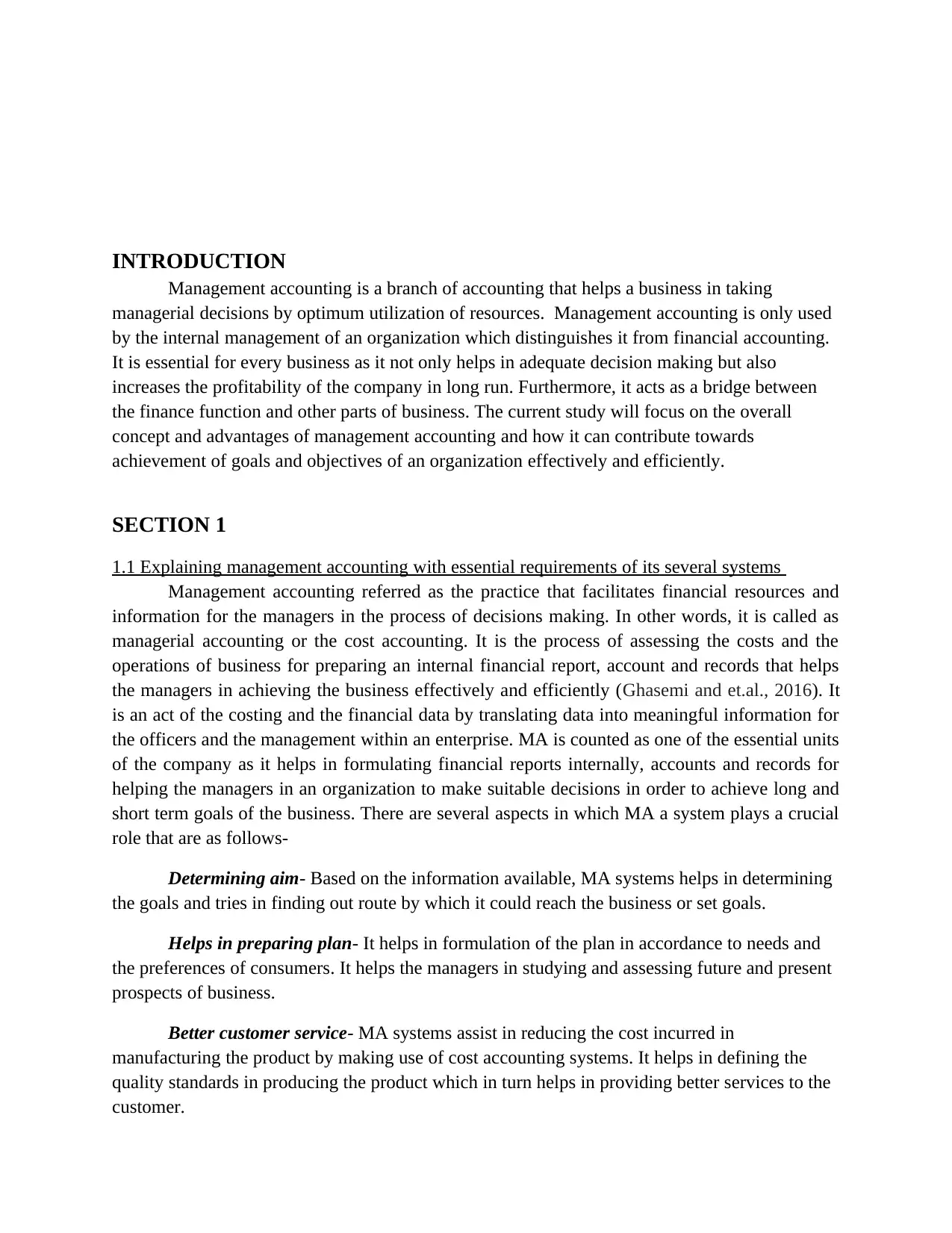
INTRODUCTION
Management accounting is a branch of accounting that helps a business in taking
managerial decisions by optimum utilization of resources. Management accounting is only used
by the internal management of an organization which distinguishes it from financial accounting.
It is essential for every business as it not only helps in adequate decision making but also
increases the profitability of the company in long run. Furthermore, it acts as a bridge between
the finance function and other parts of business. The current study will focus on the overall
concept and advantages of management accounting and how it can contribute towards
achievement of goals and objectives of an organization effectively and efficiently.
SECTION 1
1.1 Explaining management accounting with essential requirements of its several systems
Management accounting referred as the practice that facilitates financial resources and
information for the managers in the process of decisions making. In other words, it is called as
managerial accounting or the cost accounting. It is the process of assessing the costs and the
operations of business for preparing an internal financial report, account and records that helps
the managers in achieving the business effectively and efficiently (Ghasemi and et.al., 2016). It
is an act of the costing and the financial data by translating data into meaningful information for
the officers and the management within an enterprise. MA is counted as one of the essential units
of the company as it helps in formulating financial reports internally, accounts and records for
helping the managers in an organization to make suitable decisions in order to achieve long and
short term goals of the business. There are several aspects in which MA a system plays a crucial
role that are as follows-
Determining aim- Based on the information available, MA systems helps in determining
the goals and tries in finding out route by which it could reach the business or set goals.
Helps in preparing plan- It helps in formulation of the plan in accordance to needs and
the preferences of consumers. It helps the managers in studying and assessing future and present
prospects of business.
Better customer service- MA systems assist in reducing the cost incurred in
manufacturing the product by making use of cost accounting systems. It helps in defining the
quality standards in producing the product which in turn helps in providing better services to the
customer.
Management accounting is a branch of accounting that helps a business in taking
managerial decisions by optimum utilization of resources. Management accounting is only used
by the internal management of an organization which distinguishes it from financial accounting.
It is essential for every business as it not only helps in adequate decision making but also
increases the profitability of the company in long run. Furthermore, it acts as a bridge between
the finance function and other parts of business. The current study will focus on the overall
concept and advantages of management accounting and how it can contribute towards
achievement of goals and objectives of an organization effectively and efficiently.
SECTION 1
1.1 Explaining management accounting with essential requirements of its several systems
Management accounting referred as the practice that facilitates financial resources and
information for the managers in the process of decisions making. In other words, it is called as
managerial accounting or the cost accounting. It is the process of assessing the costs and the
operations of business for preparing an internal financial report, account and records that helps
the managers in achieving the business effectively and efficiently (Ghasemi and et.al., 2016). It
is an act of the costing and the financial data by translating data into meaningful information for
the officers and the management within an enterprise. MA is counted as one of the essential units
of the company as it helps in formulating financial reports internally, accounts and records for
helping the managers in an organization to make suitable decisions in order to achieve long and
short term goals of the business. There are several aspects in which MA a system plays a crucial
role that are as follows-
Determining aim- Based on the information available, MA systems helps in determining
the goals and tries in finding out route by which it could reach the business or set goals.
Helps in preparing plan- It helps in formulation of the plan in accordance to needs and
the preferences of consumers. It helps the managers in studying and assessing future and present
prospects of business.
Better customer service- MA systems assist in reducing the cost incurred in
manufacturing the product by making use of cost accounting systems. It helps in defining the
quality standards in producing the product which in turn helps in providing better services to the
customer.
⊘ This is a preview!⊘
Do you want full access?
Subscribe today to unlock all pages.

Trusted by 1+ million students worldwide
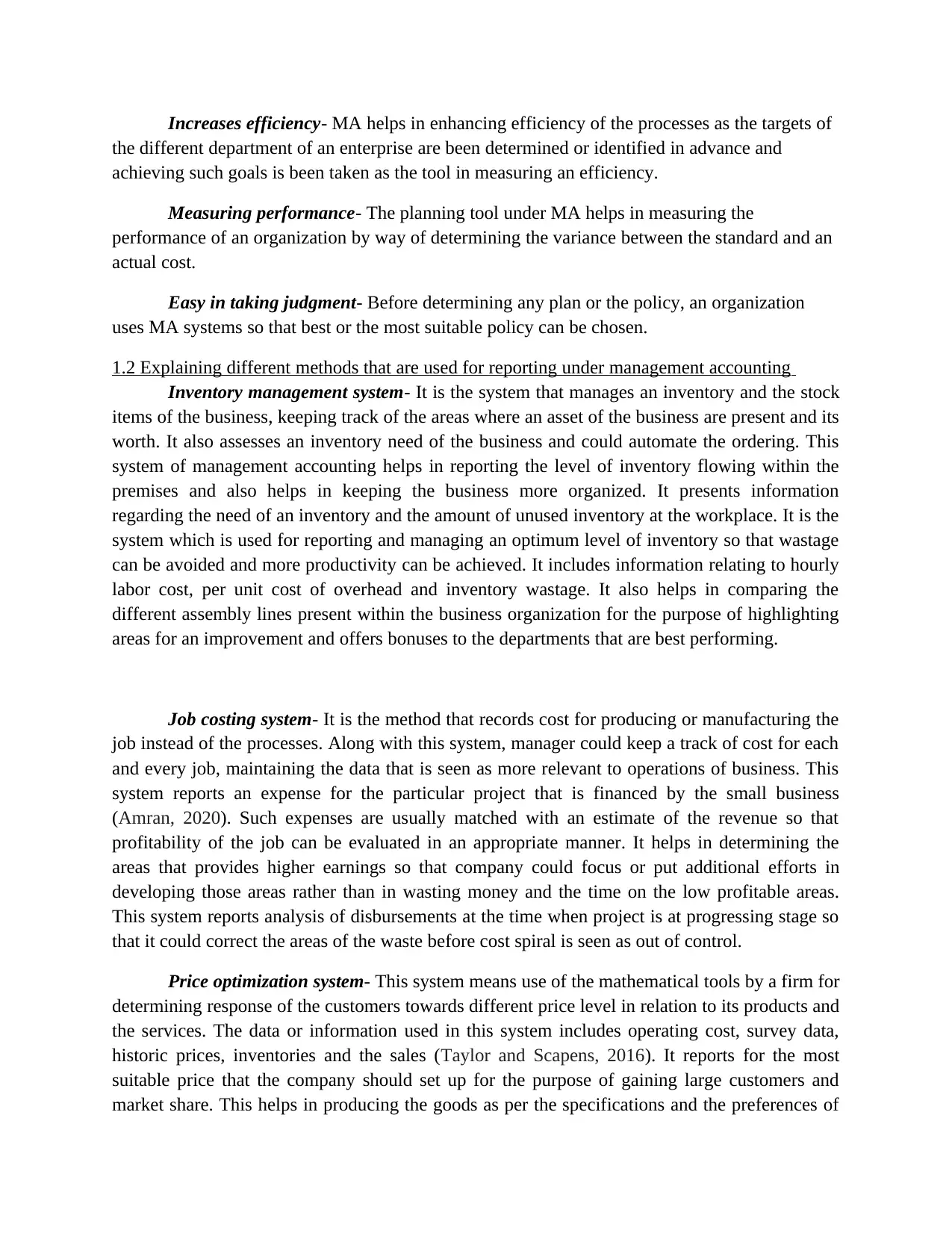
Increases efficiency- MA helps in enhancing efficiency of the processes as the targets of
the different department of an enterprise are been determined or identified in advance and
achieving such goals is been taken as the tool in measuring an efficiency.
Measuring performance- The planning tool under MA helps in measuring the
performance of an organization by way of determining the variance between the standard and an
actual cost.
Easy in taking judgment- Before determining any plan or the policy, an organization
uses MA systems so that best or the most suitable policy can be chosen.
1.2 Explaining different methods that are used for reporting under management accounting
Inventory management system- It is the system that manages an inventory and the stock
items of the business, keeping track of the areas where an asset of the business are present and its
worth. It also assesses an inventory need of the business and could automate the ordering. This
system of management accounting helps in reporting the level of inventory flowing within the
premises and also helps in keeping the business more organized. It presents information
regarding the need of an inventory and the amount of unused inventory at the workplace. It is the
system which is used for reporting and managing an optimum level of inventory so that wastage
can be avoided and more productivity can be achieved. It includes information relating to hourly
labor cost, per unit cost of overhead and inventory wastage. It also helps in comparing the
different assembly lines present within the business organization for the purpose of highlighting
areas for an improvement and offers bonuses to the departments that are best performing.
Job costing system- It is the method that records cost for producing or manufacturing the
job instead of the processes. Along with this system, manager could keep a track of cost for each
and every job, maintaining the data that is seen as more relevant to operations of business. This
system reports an expense for the particular project that is financed by the small business
(Amran, 2020). Such expenses are usually matched with an estimate of the revenue so that
profitability of the job can be evaluated in an appropriate manner. It helps in determining the
areas that provides higher earnings so that company could focus or put additional efforts in
developing those areas rather than in wasting money and the time on the low profitable areas.
This system reports analysis of disbursements at the time when project is at progressing stage so
that it could correct the areas of the waste before cost spiral is seen as out of control.
Price optimization system- This system means use of the mathematical tools by a firm for
determining response of the customers towards different price level in relation to its products and
the services. The data or information used in this system includes operating cost, survey data,
historic prices, inventories and the sales (Taylor and Scapens, 2016). It reports for the most
suitable price that the company should set up for the purpose of gaining large customers and
market share. This helps in producing the goods as per the specifications and the preferences of
the different department of an enterprise are been determined or identified in advance and
achieving such goals is been taken as the tool in measuring an efficiency.
Measuring performance- The planning tool under MA helps in measuring the
performance of an organization by way of determining the variance between the standard and an
actual cost.
Easy in taking judgment- Before determining any plan or the policy, an organization
uses MA systems so that best or the most suitable policy can be chosen.
1.2 Explaining different methods that are used for reporting under management accounting
Inventory management system- It is the system that manages an inventory and the stock
items of the business, keeping track of the areas where an asset of the business are present and its
worth. It also assesses an inventory need of the business and could automate the ordering. This
system of management accounting helps in reporting the level of inventory flowing within the
premises and also helps in keeping the business more organized. It presents information
regarding the need of an inventory and the amount of unused inventory at the workplace. It is the
system which is used for reporting and managing an optimum level of inventory so that wastage
can be avoided and more productivity can be achieved. It includes information relating to hourly
labor cost, per unit cost of overhead and inventory wastage. It also helps in comparing the
different assembly lines present within the business organization for the purpose of highlighting
areas for an improvement and offers bonuses to the departments that are best performing.
Job costing system- It is the method that records cost for producing or manufacturing the
job instead of the processes. Along with this system, manager could keep a track of cost for each
and every job, maintaining the data that is seen as more relevant to operations of business. This
system reports an expense for the particular project that is financed by the small business
(Amran, 2020). Such expenses are usually matched with an estimate of the revenue so that
profitability of the job can be evaluated in an appropriate manner. It helps in determining the
areas that provides higher earnings so that company could focus or put additional efforts in
developing those areas rather than in wasting money and the time on the low profitable areas.
This system reports analysis of disbursements at the time when project is at progressing stage so
that it could correct the areas of the waste before cost spiral is seen as out of control.
Price optimization system- This system means use of the mathematical tools by a firm for
determining response of the customers towards different price level in relation to its products and
the services. The data or information used in this system includes operating cost, survey data,
historic prices, inventories and the sales (Taylor and Scapens, 2016). It reports for the most
suitable price that the company should set up for the purpose of gaining large customers and
market share. This helps in producing the goods as per the specifications and the preferences of
Paraphrase This Document
Need a fresh take? Get an instant paraphrase of this document with our AI Paraphraser
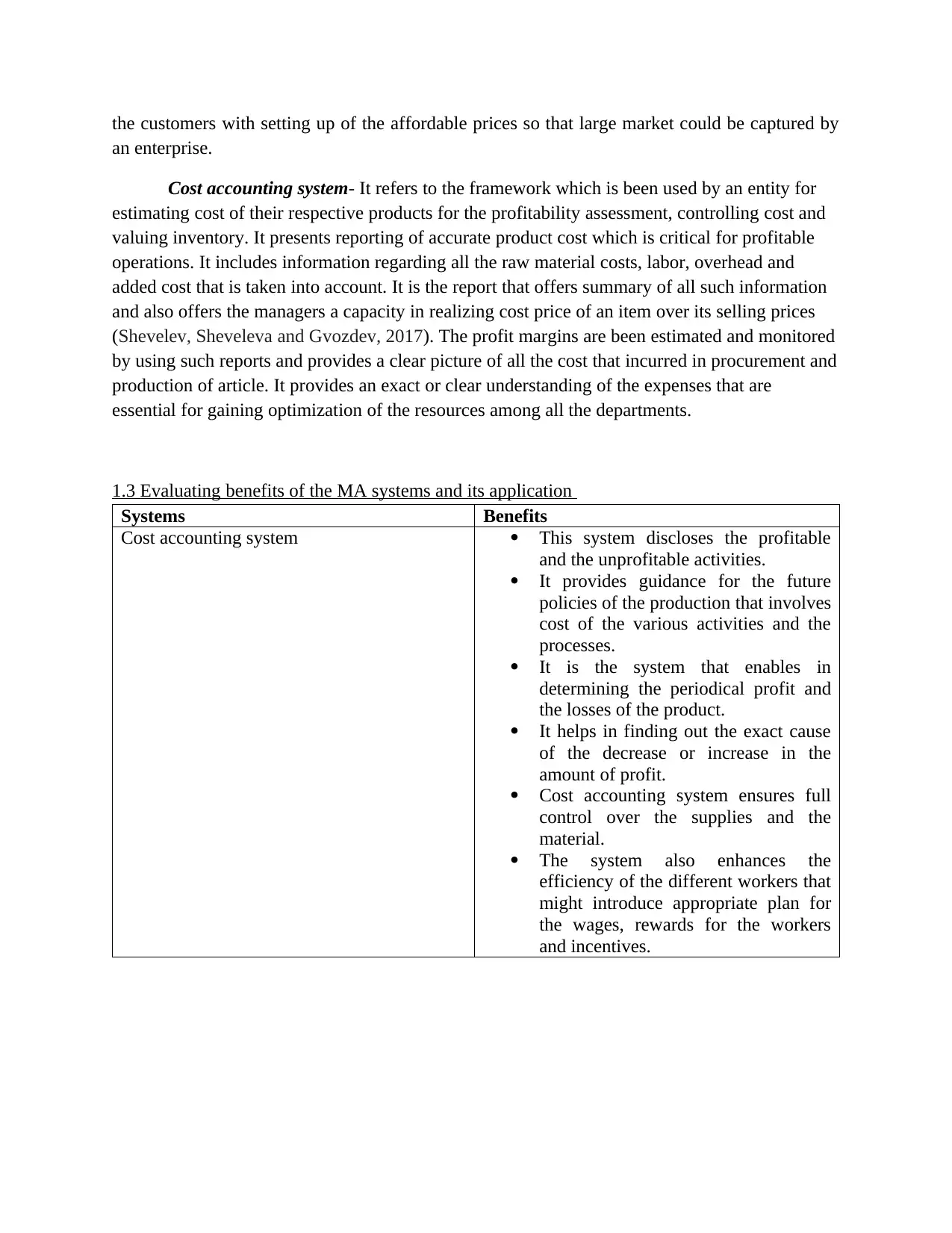
the customers with setting up of the affordable prices so that large market could be captured by
an enterprise.
Cost accounting system- It refers to the framework which is been used by an entity for
estimating cost of their respective products for the profitability assessment, controlling cost and
valuing inventory. It presents reporting of accurate product cost which is critical for profitable
operations. It includes information regarding all the raw material costs, labor, overhead and
added cost that is taken into account. It is the report that offers summary of all such information
and also offers the managers a capacity in realizing cost price of an item over its selling prices
(Shevelev, Sheveleva and Gvozdev, 2017). The profit margins are been estimated and monitored
by using such reports and provides a clear picture of all the cost that incurred in procurement and
production of article. It provides an exact or clear understanding of the expenses that are
essential for gaining optimization of the resources among all the departments.
1.3 Evaluating benefits of the MA systems and its application
Systems Benefits
Cost accounting system This system discloses the profitable
and the unprofitable activities.
It provides guidance for the future
policies of the production that involves
cost of the various activities and the
processes.
It is the system that enables in
determining the periodical profit and
the losses of the product.
It helps in finding out the exact cause
of the decrease or increase in the
amount of profit.
Cost accounting system ensures full
control over the supplies and the
material.
The system also enhances the
efficiency of the different workers that
might introduce appropriate plan for
the wages, rewards for the workers
and incentives.
an enterprise.
Cost accounting system- It refers to the framework which is been used by an entity for
estimating cost of their respective products for the profitability assessment, controlling cost and
valuing inventory. It presents reporting of accurate product cost which is critical for profitable
operations. It includes information regarding all the raw material costs, labor, overhead and
added cost that is taken into account. It is the report that offers summary of all such information
and also offers the managers a capacity in realizing cost price of an item over its selling prices
(Shevelev, Sheveleva and Gvozdev, 2017). The profit margins are been estimated and monitored
by using such reports and provides a clear picture of all the cost that incurred in procurement and
production of article. It provides an exact or clear understanding of the expenses that are
essential for gaining optimization of the resources among all the departments.
1.3 Evaluating benefits of the MA systems and its application
Systems Benefits
Cost accounting system This system discloses the profitable
and the unprofitable activities.
It provides guidance for the future
policies of the production that involves
cost of the various activities and the
processes.
It is the system that enables in
determining the periodical profit and
the losses of the product.
It helps in finding out the exact cause
of the decrease or increase in the
amount of profit.
Cost accounting system ensures full
control over the supplies and the
material.
The system also enhances the
efficiency of the different workers that
might introduce appropriate plan for
the wages, rewards for the workers
and incentives.
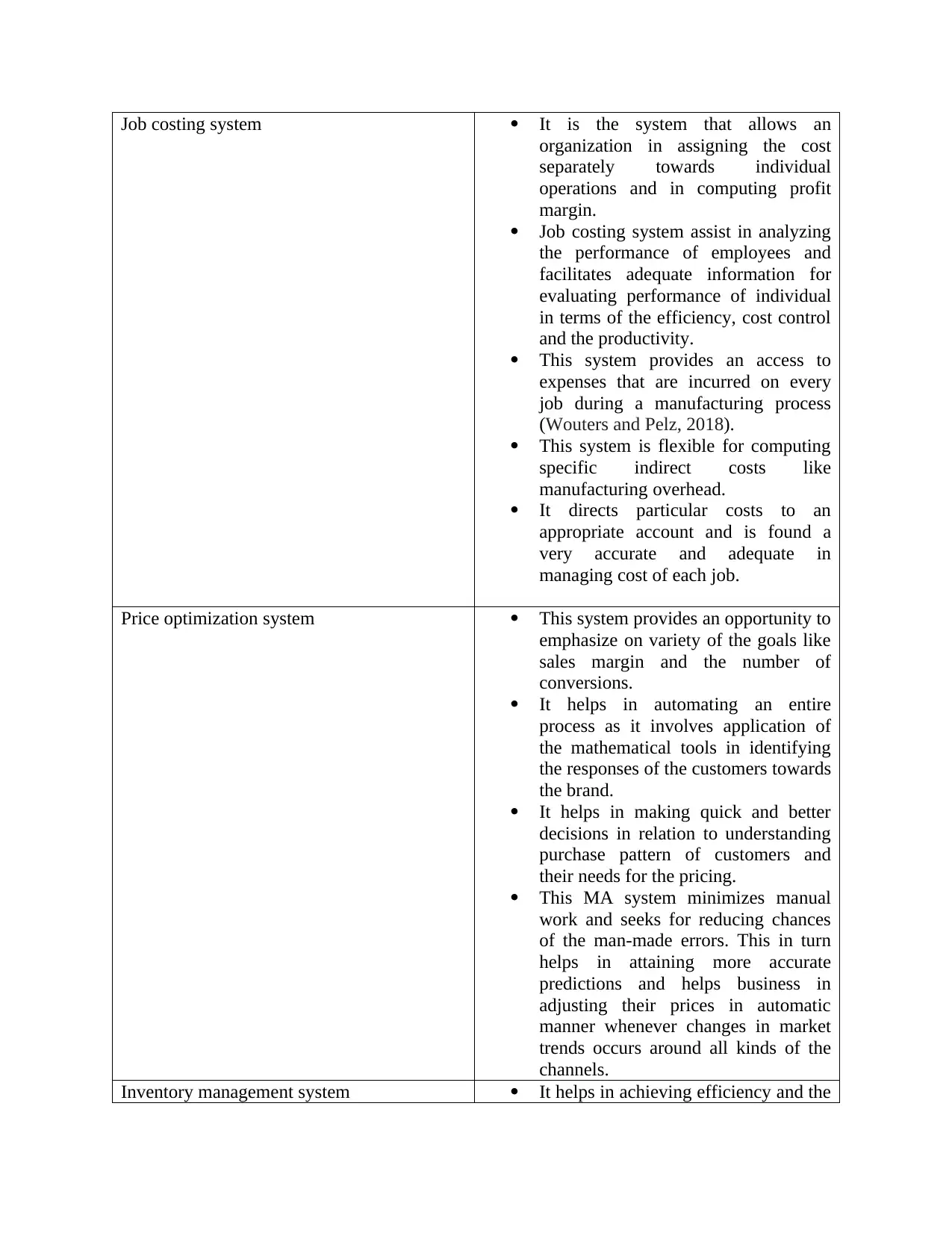
Job costing system It is the system that allows an
organization in assigning the cost
separately towards individual
operations and in computing profit
margin.
Job costing system assist in analyzing
the performance of employees and
facilitates adequate information for
evaluating performance of individual
in terms of the efficiency, cost control
and the productivity.
This system provides an access to
expenses that are incurred on every
job during a manufacturing process
(Wouters and Pelz, 2018).
This system is flexible for computing
specific indirect costs like
manufacturing overhead.
It directs particular costs to an
appropriate account and is found a
very accurate and adequate in
managing cost of each job.
Price optimization system This system provides an opportunity to
emphasize on variety of the goals like
sales margin and the number of
conversions.
It helps in automating an entire
process as it involves application of
the mathematical tools in identifying
the responses of the customers towards
the brand.
It helps in making quick and better
decisions in relation to understanding
purchase pattern of customers and
their needs for the pricing.
This MA system minimizes manual
work and seeks for reducing chances
of the man-made errors. This in turn
helps in attaining more accurate
predictions and helps business in
adjusting their prices in automatic
manner whenever changes in market
trends occurs around all kinds of the
channels.
Inventory management system It helps in achieving efficiency and the
organization in assigning the cost
separately towards individual
operations and in computing profit
margin.
Job costing system assist in analyzing
the performance of employees and
facilitates adequate information for
evaluating performance of individual
in terms of the efficiency, cost control
and the productivity.
This system provides an access to
expenses that are incurred on every
job during a manufacturing process
(Wouters and Pelz, 2018).
This system is flexible for computing
specific indirect costs like
manufacturing overhead.
It directs particular costs to an
appropriate account and is found a
very accurate and adequate in
managing cost of each job.
Price optimization system This system provides an opportunity to
emphasize on variety of the goals like
sales margin and the number of
conversions.
It helps in automating an entire
process as it involves application of
the mathematical tools in identifying
the responses of the customers towards
the brand.
It helps in making quick and better
decisions in relation to understanding
purchase pattern of customers and
their needs for the pricing.
This MA system minimizes manual
work and seeks for reducing chances
of the man-made errors. This in turn
helps in attaining more accurate
predictions and helps business in
adjusting their prices in automatic
manner whenever changes in market
trends occurs around all kinds of the
channels.
Inventory management system It helps in achieving efficiency and the
⊘ This is a preview!⊘
Do you want full access?
Subscribe today to unlock all pages.

Trusted by 1+ million students worldwide
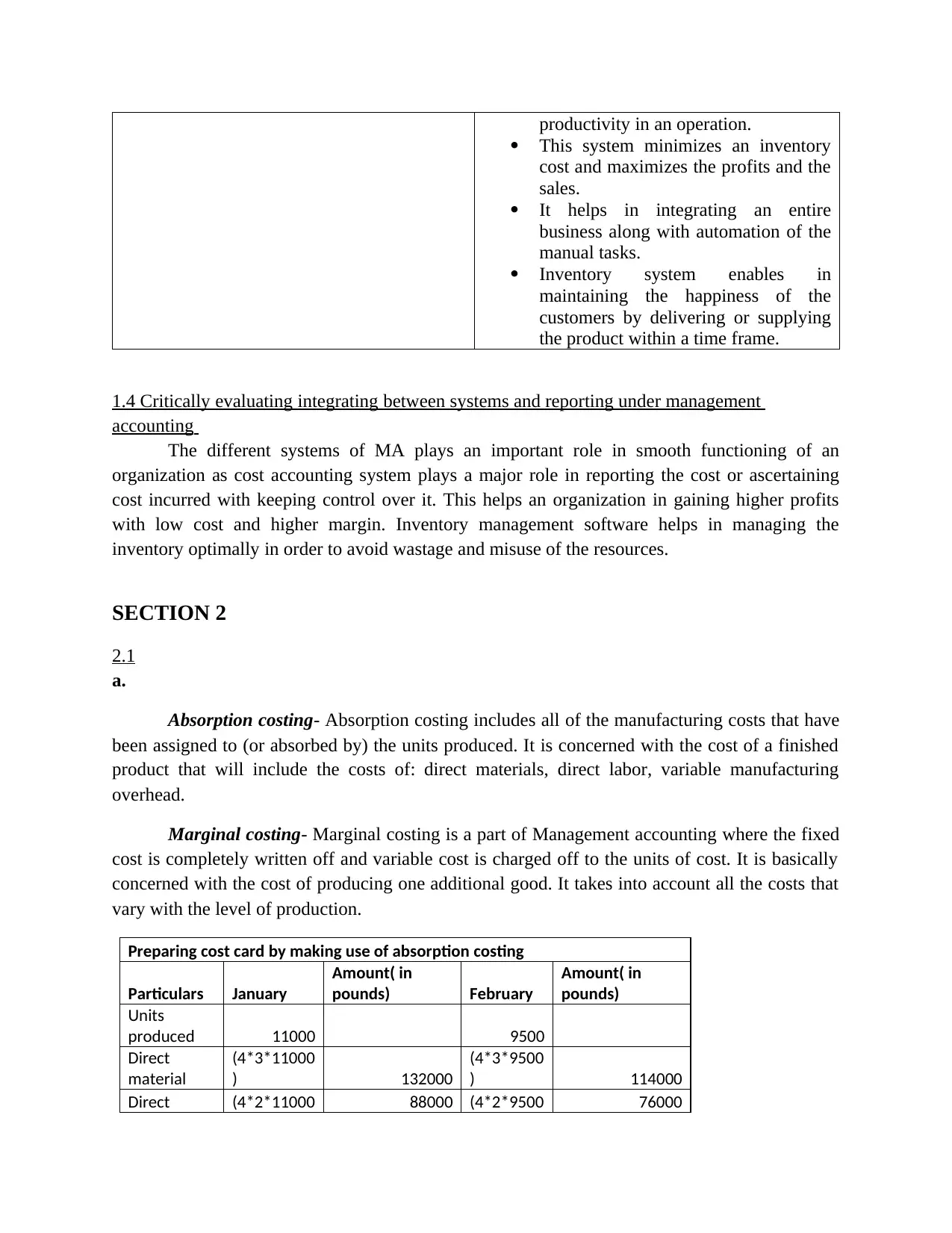
productivity in an operation.
This system minimizes an inventory
cost and maximizes the profits and the
sales.
It helps in integrating an entire
business along with automation of the
manual tasks.
Inventory system enables in
maintaining the happiness of the
customers by delivering or supplying
the product within a time frame.
1.4 Critically evaluating integrating between systems and reporting under management
accounting
The different systems of MA plays an important role in smooth functioning of an
organization as cost accounting system plays a major role in reporting the cost or ascertaining
cost incurred with keeping control over it. This helps an organization in gaining higher profits
with low cost and higher margin. Inventory management software helps in managing the
inventory optimally in order to avoid wastage and misuse of the resources.
SECTION 2
2.1
a.
Absorption costing- Absorption costing includes all of the manufacturing costs that have
been assigned to (or absorbed by) the units produced. It is concerned with the cost of a finished
product that will include the costs of: direct materials, direct labor, variable manufacturing
overhead.
Marginal costing- Marginal costing is a part of Management accounting where the fixed
cost is completely written off and variable cost is charged off to the units of cost. It is basically
concerned with the cost of producing one additional good. It takes into account all the costs that
vary with the level of production.
Preparing cost card by making use of absorption costing
Particulars January
Amount( in
pounds) February
Amount( in
pounds)
Units
produced 11000 9500
Direct
material
(4*3*11000
) 132000
(4*3*9500
) 114000
Direct (4*2*11000 88000 (4*2*9500 76000
This system minimizes an inventory
cost and maximizes the profits and the
sales.
It helps in integrating an entire
business along with automation of the
manual tasks.
Inventory system enables in
maintaining the happiness of the
customers by delivering or supplying
the product within a time frame.
1.4 Critically evaluating integrating between systems and reporting under management
accounting
The different systems of MA plays an important role in smooth functioning of an
organization as cost accounting system plays a major role in reporting the cost or ascertaining
cost incurred with keeping control over it. This helps an organization in gaining higher profits
with low cost and higher margin. Inventory management software helps in managing the
inventory optimally in order to avoid wastage and misuse of the resources.
SECTION 2
2.1
a.
Absorption costing- Absorption costing includes all of the manufacturing costs that have
been assigned to (or absorbed by) the units produced. It is concerned with the cost of a finished
product that will include the costs of: direct materials, direct labor, variable manufacturing
overhead.
Marginal costing- Marginal costing is a part of Management accounting where the fixed
cost is completely written off and variable cost is charged off to the units of cost. It is basically
concerned with the cost of producing one additional good. It takes into account all the costs that
vary with the level of production.
Preparing cost card by making use of absorption costing
Particulars January
Amount( in
pounds) February
Amount( in
pounds)
Units
produced 11000 9500
Direct
material
(4*3*11000
) 132000
(4*3*9500
) 114000
Direct (4*2*11000 88000 (4*2*9500 76000
Paraphrase This Document
Need a fresh take? Get an instant paraphrase of this document with our AI Paraphraser
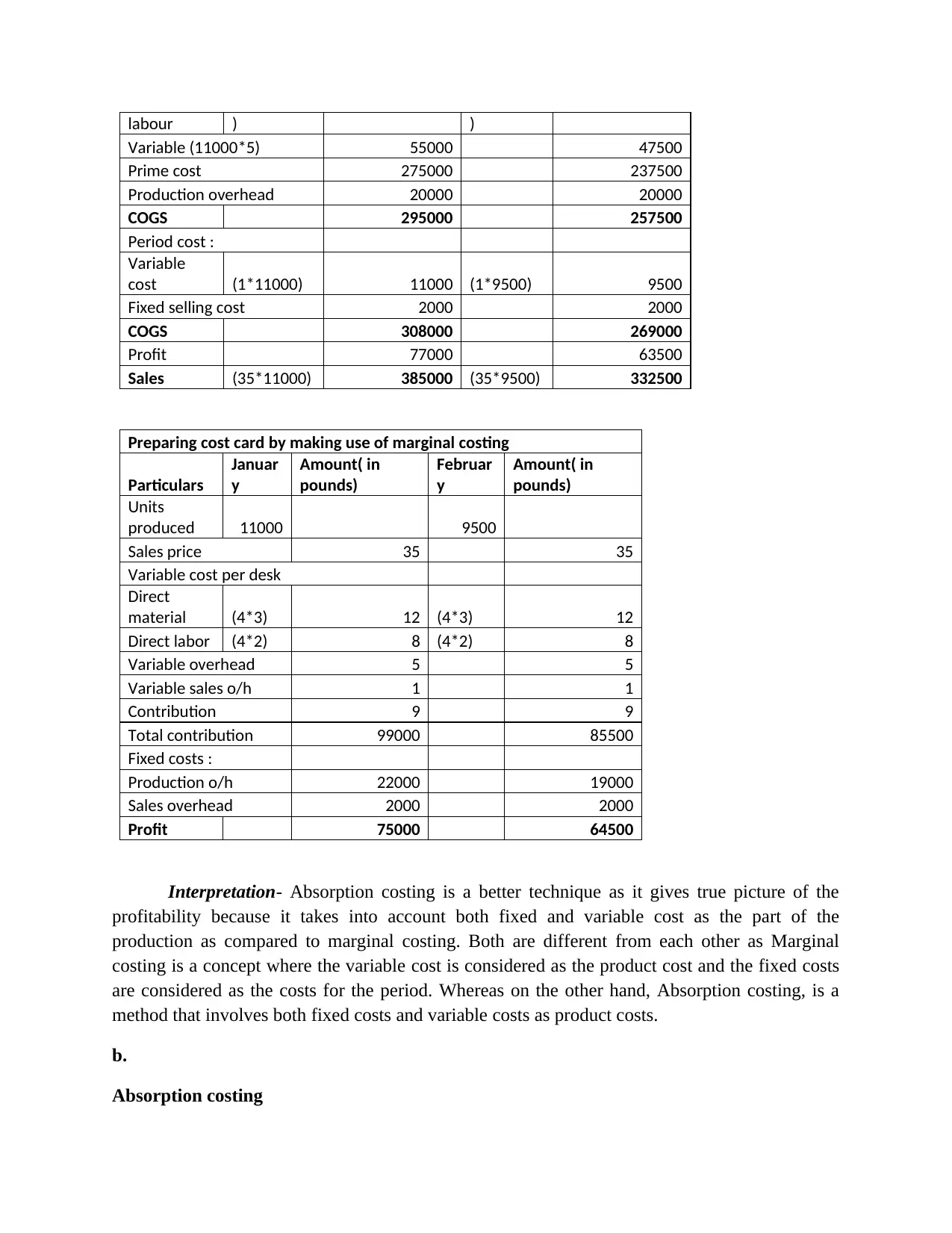
labour ) )
Variable (11000*5) 55000 47500
Prime cost 275000 237500
Production overhead 20000 20000
COGS 295000 257500
Period cost :
Variable
cost (1*11000) 11000 (1*9500) 9500
Fixed selling cost 2000 2000
COGS 308000 269000
Profit 77000 63500
Sales (35*11000) 385000 (35*9500) 332500
Preparing cost card by making use of marginal costing
Particulars
Januar
y
Amount( in
pounds)
Februar
y
Amount( in
pounds)
Units
produced 11000 9500
Sales price 35 35
Variable cost per desk
Direct
material (4*3) 12 (4*3) 12
Direct labor (4*2) 8 (4*2) 8
Variable overhead 5 5
Variable sales o/h 1 1
Contribution 9 9
Total contribution 99000 85500
Fixed costs :
Production o/h 22000 19000
Sales overhead 2000 2000
Profit 75000 64500
Interpretation- Absorption costing is a better technique as it gives true picture of the
profitability because it takes into account both fixed and variable cost as the part of the
production as compared to marginal costing. Both are different from each other as Marginal
costing is a concept where the variable cost is considered as the product cost and the fixed costs
are considered as the costs for the period. Whereas on the other hand, Absorption costing, is a
method that involves both fixed costs and variable costs as product costs.
b.
Absorption costing
Variable (11000*5) 55000 47500
Prime cost 275000 237500
Production overhead 20000 20000
COGS 295000 257500
Period cost :
Variable
cost (1*11000) 11000 (1*9500) 9500
Fixed selling cost 2000 2000
COGS 308000 269000
Profit 77000 63500
Sales (35*11000) 385000 (35*9500) 332500
Preparing cost card by making use of marginal costing
Particulars
Januar
y
Amount( in
pounds)
Februar
y
Amount( in
pounds)
Units
produced 11000 9500
Sales price 35 35
Variable cost per desk
Direct
material (4*3) 12 (4*3) 12
Direct labor (4*2) 8 (4*2) 8
Variable overhead 5 5
Variable sales o/h 1 1
Contribution 9 9
Total contribution 99000 85500
Fixed costs :
Production o/h 22000 19000
Sales overhead 2000 2000
Profit 75000 64500
Interpretation- Absorption costing is a better technique as it gives true picture of the
profitability because it takes into account both fixed and variable cost as the part of the
production as compared to marginal costing. Both are different from each other as Marginal
costing is a concept where the variable cost is considered as the product cost and the fixed costs
are considered as the costs for the period. Whereas on the other hand, Absorption costing, is a
method that involves both fixed costs and variable costs as product costs.
b.
Absorption costing
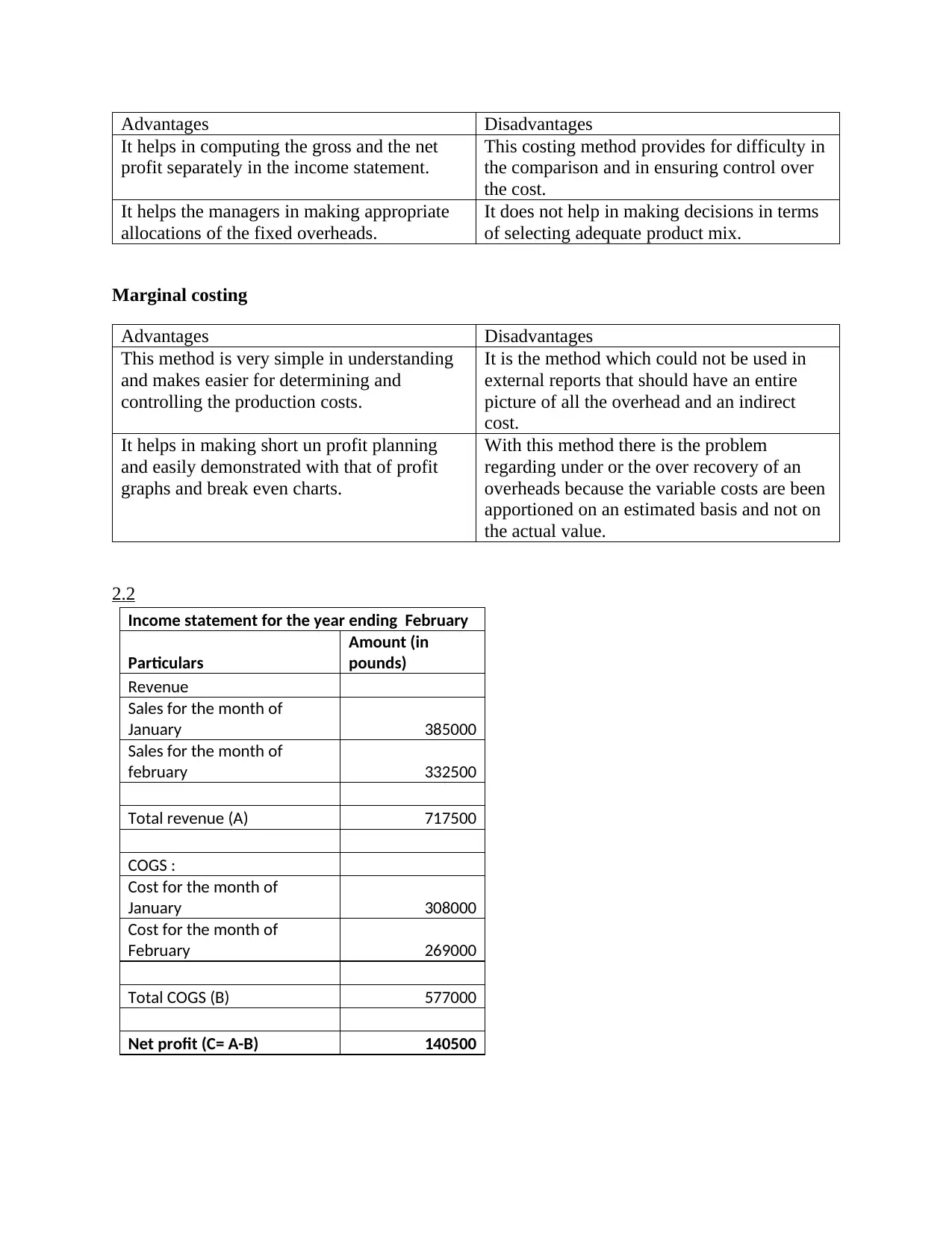
Advantages Disadvantages
It helps in computing the gross and the net
profit separately in the income statement.
This costing method provides for difficulty in
the comparison and in ensuring control over
the cost.
It helps the managers in making appropriate
allocations of the fixed overheads.
It does not help in making decisions in terms
of selecting adequate product mix.
Marginal costing
Advantages Disadvantages
This method is very simple in understanding
and makes easier for determining and
controlling the production costs.
It is the method which could not be used in
external reports that should have an entire
picture of all the overhead and an indirect
cost.
It helps in making short un profit planning
and easily demonstrated with that of profit
graphs and break even charts.
With this method there is the problem
regarding under or the over recovery of an
overheads because the variable costs are been
apportioned on an estimated basis and not on
the actual value.
2.2
Income statement for the year ending February
Particulars
Amount (in
pounds)
Revenue
Sales for the month of
January 385000
Sales for the month of
february 332500
Total revenue (A) 717500
COGS :
Cost for the month of
January 308000
Cost for the month of
February 269000
Total COGS (B) 577000
Net profit (C= A-B) 140500
It helps in computing the gross and the net
profit separately in the income statement.
This costing method provides for difficulty in
the comparison and in ensuring control over
the cost.
It helps the managers in making appropriate
allocations of the fixed overheads.
It does not help in making decisions in terms
of selecting adequate product mix.
Marginal costing
Advantages Disadvantages
This method is very simple in understanding
and makes easier for determining and
controlling the production costs.
It is the method which could not be used in
external reports that should have an entire
picture of all the overhead and an indirect
cost.
It helps in making short un profit planning
and easily demonstrated with that of profit
graphs and break even charts.
With this method there is the problem
regarding under or the over recovery of an
overheads because the variable costs are been
apportioned on an estimated basis and not on
the actual value.
2.2
Income statement for the year ending February
Particulars
Amount (in
pounds)
Revenue
Sales for the month of
January 385000
Sales for the month of
february 332500
Total revenue (A) 717500
COGS :
Cost for the month of
January 308000
Cost for the month of
February 269000
Total COGS (B) 577000
Net profit (C= A-B) 140500
⊘ This is a preview!⊘
Do you want full access?
Subscribe today to unlock all pages.

Trusted by 1+ million students worldwide
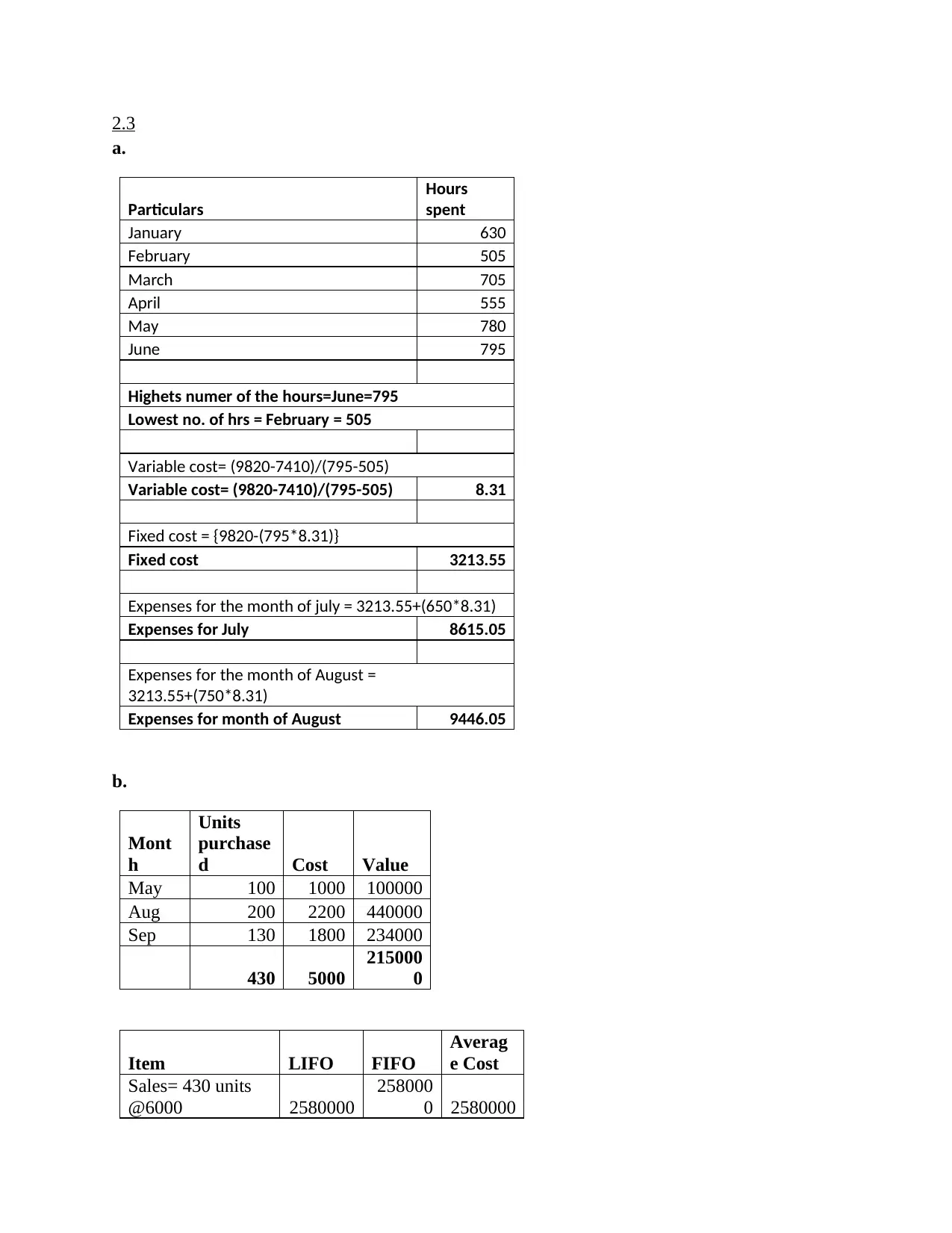
2.3
a.
Particulars
Hours
spent
January 630
February 505
March 705
April 555
May 780
June 795
Highets numer of the hours=June=795
Lowest no. of hrs = February = 505
Variable cost= (9820-7410)/(795-505)
Variable cost= (9820-7410)/(795-505) 8.31
Fixed cost = {9820-(795*8.31)}
Fixed cost 3213.55
Expenses for the month of july = 3213.55+(650*8.31)
Expenses for July 8615.05
Expenses for the month of August =
3213.55+(750*8.31)
Expenses for month of August 9446.05
b.
Mont
h
Units
purchase
d Cost Value
May 100 1000 100000
Aug 200 2200 440000
Sep 130 1800 234000
430 5000
215000
0
Item LIFO FIFO
Averag
e Cost
Sales= 430 units
@6000 2580000
258000
0 2580000
a.
Particulars
Hours
spent
January 630
February 505
March 705
April 555
May 780
June 795
Highets numer of the hours=June=795
Lowest no. of hrs = February = 505
Variable cost= (9820-7410)/(795-505)
Variable cost= (9820-7410)/(795-505) 8.31
Fixed cost = {9820-(795*8.31)}
Fixed cost 3213.55
Expenses for the month of july = 3213.55+(650*8.31)
Expenses for July 8615.05
Expenses for the month of August =
3213.55+(750*8.31)
Expenses for month of August 9446.05
b.
Mont
h
Units
purchase
d Cost Value
May 100 1000 100000
Aug 200 2200 440000
Sep 130 1800 234000
430 5000
215000
0
Item LIFO FIFO
Averag
e Cost
Sales= 430 units
@6000 2580000
258000
0 2580000
Paraphrase This Document
Need a fresh take? Get an instant paraphrase of this document with our AI Paraphraser
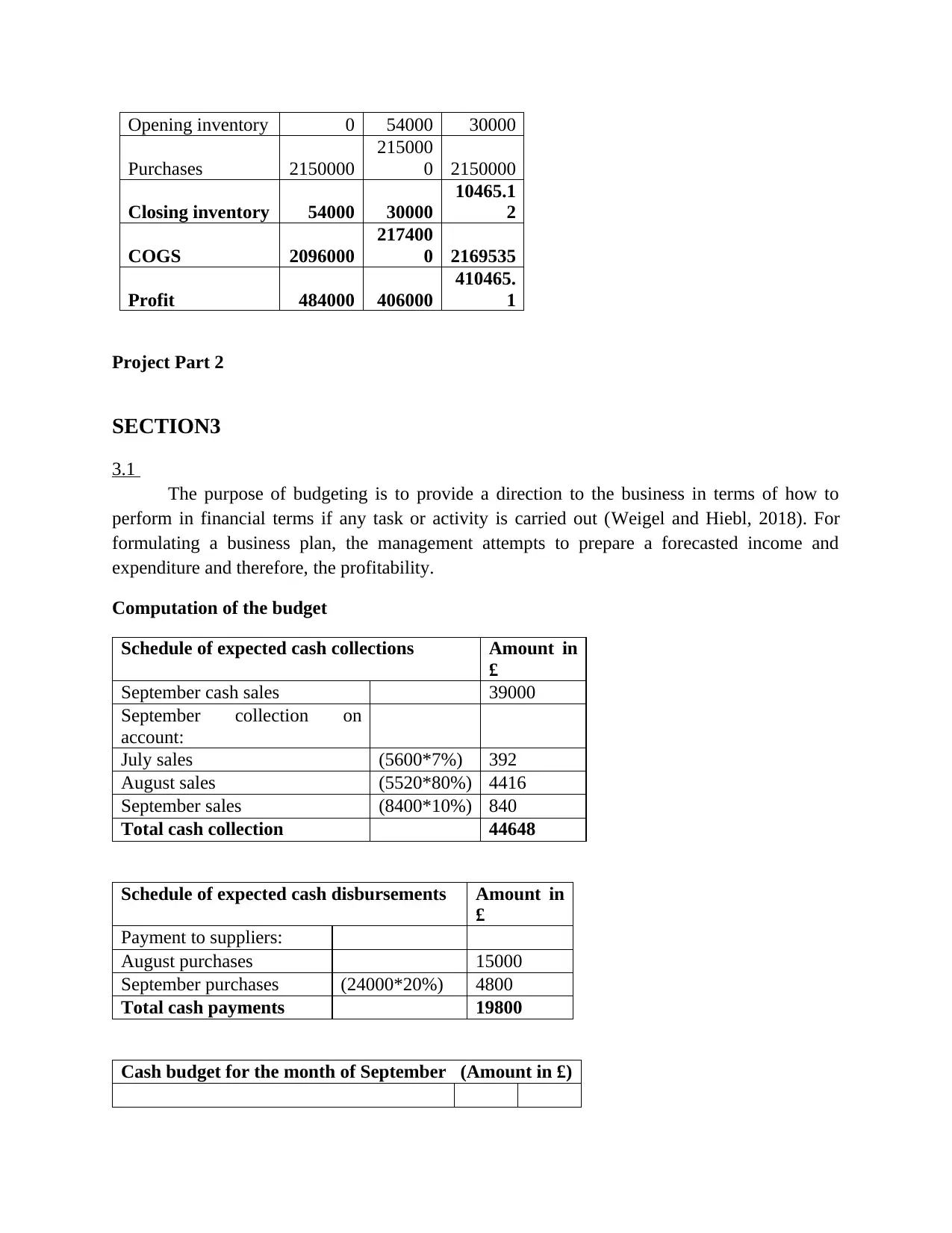
Opening inventory 0 54000 30000
Purchases 2150000
215000
0 2150000
Closing inventory 54000 30000
10465.1
2
COGS 2096000
217400
0 2169535
Profit 484000 406000
410465.
1
Project Part 2
SECTION3
3.1
The purpose of budgeting is to provide a direction to the business in terms of how to
perform in financial terms if any task or activity is carried out (Weigel and Hiebl, 2018). For
formulating a business plan, the management attempts to prepare a forecasted income and
expenditure and therefore, the profitability.
Computation of the budget
Schedule of expected cash collections Amount in
£
September cash sales 39000
September collection on
account:
July sales (5600*7%) 392
August sales (5520*80%) 4416
September sales (8400*10%) 840
Total cash collection 44648
Schedule of expected cash disbursements Amount in
£
Payment to suppliers:
August purchases 15000
September purchases (24000*20%) 4800
Total cash payments 19800
Cash budget for the month of September (Amount in £)
Purchases 2150000
215000
0 2150000
Closing inventory 54000 30000
10465.1
2
COGS 2096000
217400
0 2169535
Profit 484000 406000
410465.
1
Project Part 2
SECTION3
3.1
The purpose of budgeting is to provide a direction to the business in terms of how to
perform in financial terms if any task or activity is carried out (Weigel and Hiebl, 2018). For
formulating a business plan, the management attempts to prepare a forecasted income and
expenditure and therefore, the profitability.
Computation of the budget
Schedule of expected cash collections Amount in
£
September cash sales 39000
September collection on
account:
July sales (5600*7%) 392
August sales (5520*80%) 4416
September sales (8400*10%) 840
Total cash collection 44648
Schedule of expected cash disbursements Amount in
£
Payment to suppliers:
August purchases 15000
September purchases (24000*20%) 4800
Total cash payments 19800
Cash budget for the month of September (Amount in £)
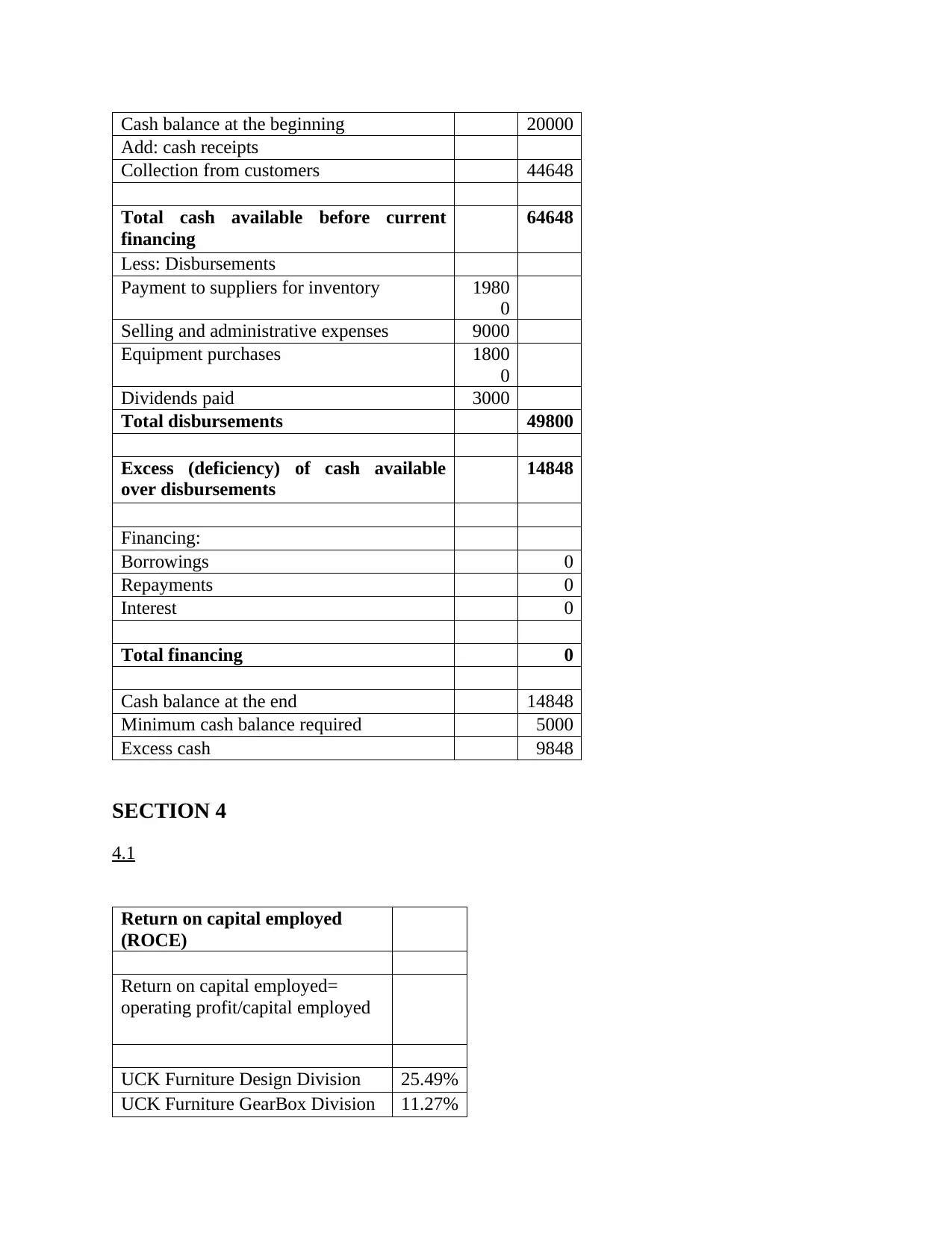
Cash balance at the beginning 20000
Add: cash receipts
Collection from customers 44648
Total cash available before current
financing
64648
Less: Disbursements
Payment to suppliers for inventory 1980
0
Selling and administrative expenses 9000
Equipment purchases 1800
0
Dividends paid 3000
Total disbursements 49800
Excess (deficiency) of cash available
over disbursements
14848
Financing:
Borrowings 0
Repayments 0
Interest 0
Total financing 0
Cash balance at the end 14848
Minimum cash balance required 5000
Excess cash 9848
SECTION 4
4.1
Return on capital employed
(ROCE)
Return on capital employed=
operating profit/capital employed
UCK Furniture Design Division 25.49%
UCK Furniture GearBox Division 11.27%
Add: cash receipts
Collection from customers 44648
Total cash available before current
financing
64648
Less: Disbursements
Payment to suppliers for inventory 1980
0
Selling and administrative expenses 9000
Equipment purchases 1800
0
Dividends paid 3000
Total disbursements 49800
Excess (deficiency) of cash available
over disbursements
14848
Financing:
Borrowings 0
Repayments 0
Interest 0
Total financing 0
Cash balance at the end 14848
Minimum cash balance required 5000
Excess cash 9848
SECTION 4
4.1
Return on capital employed
(ROCE)
Return on capital employed=
operating profit/capital employed
UCK Furniture Design Division 25.49%
UCK Furniture GearBox Division 11.27%
⊘ This is a preview!⊘
Do you want full access?
Subscribe today to unlock all pages.

Trusted by 1+ million students worldwide
1 out of 17
Related Documents
Your All-in-One AI-Powered Toolkit for Academic Success.
+13062052269
info@desklib.com
Available 24*7 on WhatsApp / Email
![[object Object]](/_next/static/media/star-bottom.7253800d.svg)
Unlock your academic potential
Copyright © 2020–2025 A2Z Services. All Rights Reserved. Developed and managed by ZUCOL.





